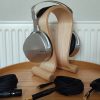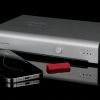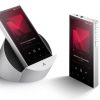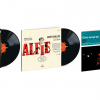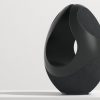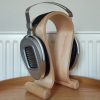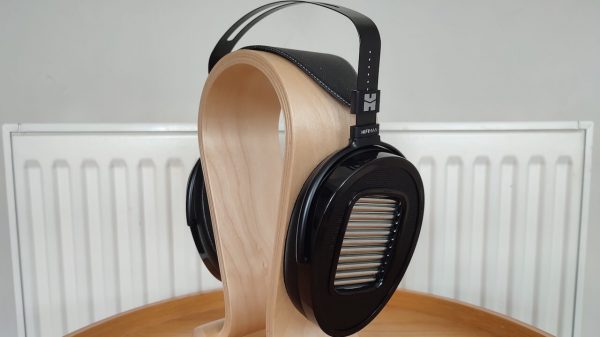HiFiMAN Electronics, the high-end audio powerhouse out of Tianjin, China, has made a name for itself by pushing boundaries in headphone design. In just over a decade, they’ve delivered some of the most compelling over-ear headphones in the game—combining massive, ultra-thin planar-magnetic drivers with serious audiophile value.
Enter the Isvarna—HiFiMAN’s bold first stab at a hybrid design. This isn’t your average mashup. Each cup houses both a dynamic driver and a full-size planar driver, arranged in a way no other brand has dared attempt. It’s experimental. It’s ambitious. It’s pure HiFiMAN.
But let’s be honest: HiFiMAN’s closed-back track record? Spotty at best. The Sundara Closed felt like a muffled shadow of its open-back sibling, and Audivina? Let’s just say “acquired taste” would be generous. So the question is—has the Isvarna finally broken the closed-back curse?
Isvarna means “thunderstorm” in Romanian—and at $2,899, HiFiMAN’s latest might just live up to the name. Will it send shockwaves through the Head-fi community or finally lift the brand’s long-running closed-back curse? One thing’s certain: the Isvarna is going to surprise a lot of people. It won’t be everyone’s cup of tea—but let’s be honest, if it isn’t yours, that’s your loss.

Technology
Let’s break down exactly how HiFiMAN has implemented the Isvarna’s hybrid driver system—because this isn’t just tech for tech’s sake.
Inside each ear cup, you’ll find two drivers working in tandem: a small dynamic driver acting as a subwoofer to handle bass frequencies, and a full-size planar magnetic driver responsible for the mids and highs. The division of labor is precise, with a crossover splitting their duties right at 300Hz.
What makes this setup unique is the placement. The dynamic driver is positioned perpendicular to the planar driver—an intentional move by HiFiMAN to reduce phase issues. Normally, having two different types of drivers firing sound waves from different angles can create timing and imaging problems, but by angling the subwoofer this way, HiFiMAN claims they’ve achieved a more coherent soundstage.
As expected with many of the brand’s planar headphones, the Isvarna features HiFiMAN’s signature Stealth Magnets. Unlike traditional squared-off magnets, these rounded ones reduce air turbulence and minimize distortion by allowing sound waves to pass through with fewer obstructions. They’re also double-sided, which HiFiMAN says helps enhance dynamic performance—giving the Isvarna both detail and punch where it counts.
The Isvarna also features HiFiMAN’s Nanometer Thickness Diaphragm technology, a hallmark of the brand’s most advanced planar designs. The diaphragm used in the planar magnetic driver is less than a millionth of a meter thick—placing it firmly in the nanometer scale. That ultra-thin substrate keeps the diaphragm’s mass in the microgram range, dramatically reducing inertia.
Why does that matter? A lighter diaphragm can accelerate and decelerate more quickly, which translates into faster transients, improved responsiveness, and a more dynamic, detailed presentation across the frequency range. In theory, this means sharper attack, cleaner decay, and more lifelike reproduction of instruments and vocals.
But does this cutting-edge material science actually result in better sound? We’ll explore that in detail in the listening section of this review.

Design & Comfort
The HiFiMAN Isvarna arrives in a brown, rectangular padded leather case with a metal front plate—an unboxing experience that immediately feels premium and purposeful. Inside, you’ll find the headphones, a hardback user manual, supporting documentation, and three included cables.
HiFiMAN includes a solid trio of stock cables: a 1.5-meter 3.5mm for portable use, plus two 3-meter options—one terminated in 4-pin XLR and the other in a quarter-inch jack. A 4.4mm balanced option would’ve been a nice touch for modern portable rigs, but honestly, getting three decently pliable cables in the box is already ahead of the curve.
With dual 3.5mm inputs on the headphones, rolling your own custom cable is painless—so whether you’re a balanced purist or just picky about aesthetics, you’re covered.
Aesthetically, the Isvarna looks undeniably cool in the hands—futuristic, sleek, and clearly high-end. But once they’re on your head, that slick sci-fi vibe gives way to something a bit more… Frankenstein chic. They’re bulky, a little unwieldy, and not exactly flattering unless your idea of fashion is “audiophile cyborg.” Still, if you’re chasing performance over catwalk points, you’ll probably forgive the fit.
Despite their imposing size, the Isvarna is surprisingly manageable on the head, especially for a closed-back planar. At 462 grams, they’re not featherweight—but thanks to the familiar HE1000-style steel headband and plush suede leather strap, the weight is distributed beautifully across the top of the head. No hot spots, no neck strain—just a secure, well-balanced fit.
Comfort is where the Isvarna quietly excels. The hybrid earpads are soft, generously deep, and spacious enough to accommodate all but the most comically oversized ears. Combined with the excellent seal and stable fit, they make long listening sessions feel effortless—just you, the music, and none of the usual headphone fatigue.
There are a couple of quirks I noticed while wearing the Isvarna that are worth mentioning. The ear cups are crafted from lightweight aluminum, which helps keep the overall weight down—but they also tend to resonate. Any light touch or adjustment, like rotating the cups, produces audible twangs and echoes that can momentarily break immersion. It’s not a dealbreaker, but it’s mildly annoying, especially for fidgety listeners.
Additionally, the HiFiMAN Isvarna isn’t a true passive isolation champ. Each cup features vents for the dynamic driver, and those do allow a noticeable amount of sound to leak out. If you’re listening at moderate to high volumes, the person next to you will definitely hear what you’re into. And while they do seal well on the head, these vents also let in a bit of ambient noise—so if you’re looking for total sonic solitude, this probably isn’t your go-to. The reality is that very few headphones get it perfectly right in that regard — and that includes some of the most expensive on the market.
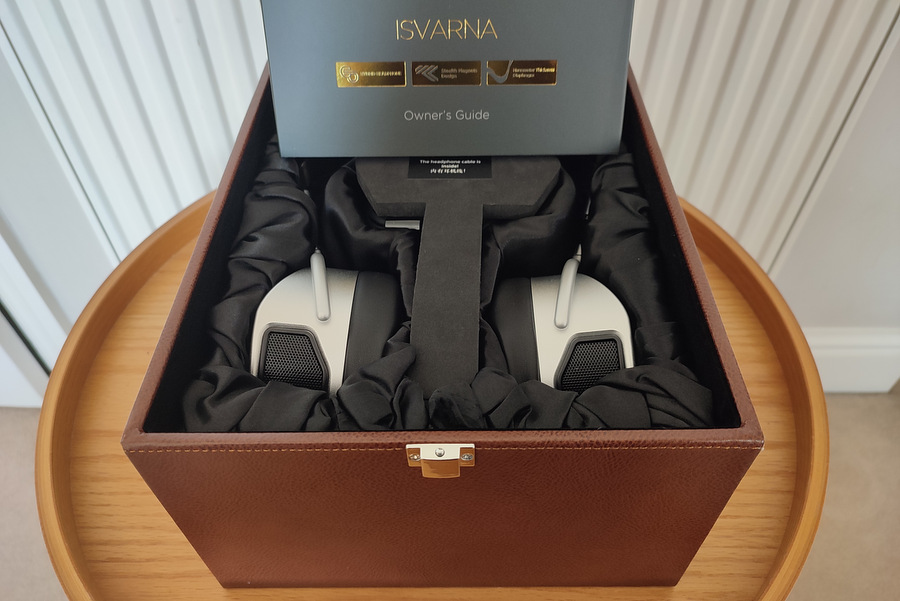
Listening
To evaluate the Isvarna’s performance across different power levels, I tested them with both portable and desktop setups to see how they scaled with better amplification.
For portable use, I paired them with the iFi GO Link Max, a compact but capable dongle DAC. On the desktop side, I used two setups: the JDS Labs Element IV DAC/Amp for a clean, neutral reference, and the more powerful Aune S17 Pro paired with the SMSL DO400 for a balanced, high-headroom experience. This gave me a well-rounded picture of how the Isvarna responds to varying levels of power and source quality.
I listened to a mix of Spotify streams and hi-res FLAC files, sourced from both my smartphone and laptop, to get a broad sense of how the Isvarna handles different file formats and playback quality.
In short, the Isvarna is not a neutral-sounding headphone—and that’s kind of the point. Its frequency response won’t please the ruler-flat crowd, but the colorations here feel deliberate and musical, not sloppy or excessive.
What you get is a rare combo: a fun, engaging sound signature paired with serious technical chops, something that’s surprisingly elusive even in the multi-kilobuck range. It’s proof that listening still matters more than looking at graphs. So to the FR graph purists clutching their Harman curves like holy scripts—maybe take off the lab coat and actually listen for once.

Bass
The lower frequencies dominate the Isvarna, and it’s impossible to miss. Surprisingly, though, it doesn’t descend into a muddy mess.
There’s no shortage of bass, and yes, your attention is drawn to the bass guitars, cellos, and deep synth rumbles. However, the bass is so incredibly well-defined and textured that it enhances, rather than overwhelms, the overall listening experience, adding layers of depth to the music.
The bass is driven by a dynamic driver subwoofer, giving it a lifelike decay and realistic timbre that planar magnetic headphones often struggle to match. The subbass extension, in particular, outperforms any dynamic driver headphone in its price range, including heavy hitters like the original Focal Utopia and Grado HP100 SE.
While the Isvarna leans toward a midbass-dominant profile, the subbass remains clearly audible and elevated, providing a rich foundation without overshadowing the rest of the frequency response.
Take Hans Zimmer and James Newton Howard’s “Why So Serious“ as an example. There’s a moment in the track where a deep 20Hz rumble plays for about twenty seconds. The Isvarna reproduced that subbass flawlessly, and at moderate listening volumes, it was loud enough to make my eardrums flutter. The precision and power in the low end were impressive, creating an immersive listening experience.
Midrange
Despite the elevated bass, the midrange remains clear and well-textured, with no muddiness caused by the prominent lower frequencies. While vocals, particularly male vocals, are slightly recessed compared to something like the similarly priced Dan Clark Audio E3, this adds a pleasing sense of spaciousness to the overall sound. It enhances the depth and openness of the track, allowing other elements of the music to breathe and shine.
I noticed this when listening to Alina Baraz and Galimatias’ “Make You Feel.” Baraz’s breathy vocals take a small step back from center stage, but your attention is naturally drawn to the stunning sense of space and holography in the well-recorded track. In fact, the Isvarna sounds so open that, at times, I almost forgot they were a closed-back pair of headphones.
Much like the bass, the midrange is highly dynamic, with instrument hits and vocal textures beautifully reproduced, delivering a tangible physical impact that’s felt as much as it’s heard.
Treble
The first thing I noticed about the treble of the Isvarna is its noticeably elevated upper treble, somewhere between 10kHz and 15kHz. It’s somewhat similar to HiFiMAN’s Arya Organic or the Meze Audio POET, but with a slightly less intense edge, making it more tolerable for all but the most treble-sensitive listeners.
However, I have nothing but praise for the rest of the upper frequencies. The treble is well-balanced, with no harsh peaks, striking a perfect balance. “Smooth” is the word that comes to mind, yet it remains vivid and dynamic when the music demands it, offering both clarity and contrast without ever feeling overly sharp.
Imaging & Soundstage
I’ve already touched on the soundstaging capabilities of the HiFiMAN Isvarna, and how it occasionally convinces me it’s an open-back pair of headphones.
While this is certainly true for some tracks, I do occasionally sense a boundary to the sound on others. The soundstage is spacious and wide, but there are moments when you can detect a limit to how far the sound can extend—something that’s not typically present with many open-back headphones.
That said, the imaging performance of the Isvarna is incredibly precise, even with the pronounced bass in its frequency response. To test imaging, I often turn to “Chocolate Chip Trip” by TOOL, and the Isvarna delivered the song’s complex passages with pinpoint accuracy, offering a truly holographic spatial presentation that made every element feel sharply defined and well-placed.
Drivability
The Isvarna has an impedance of 16 Ohms and a sensitivity of 93dB/mW. This combination of low impedance and low sensitivity means that not all amplifiers—whether tube, hybrid, or solid-state—will drive the headphones effortlessly. Even some solid-state amplifiers experience a drop in power output when driving headphones with an impedance below 32 Ohms, though this is becoming less common.
Fortunately, none of my amplifiers had this issue, and for the most part, the HiFiMAN Isvarna is relatively easy to drive. However, it does scale in sonic performance with better source gear, at least based on my impressions, showing noticeable improvements when paired with higher-quality amplification.
I first connected the Isvarna to the iFi GO Link Max, a small dongle DAC capable of pushing 241mW into 32 Ohms. While the listening experience was still enjoyable, I noticed the midrange lost some of its usual fullness, and the note decay became a bit blurred. Definitely not enough power or control in this scenario.
Upgrading to the JDS Element IV resolved the midrange issue, and I was able to unlock the full potential of the Isvarna’s impressive transient performance.
The S17 Pro amplifier, despite offering almost four times the power of the Element IV, didn’t add any extra dynamism to the Isvarna’s sound. However, the Class A circuitry did improve soundstage width and layering, making for a more immersive experience. Considering I was hesitant to wear the Isvarna outside (due to its futuristic design), I found the most enjoyable listening experience came through the S17 Pro/DO400 stack.
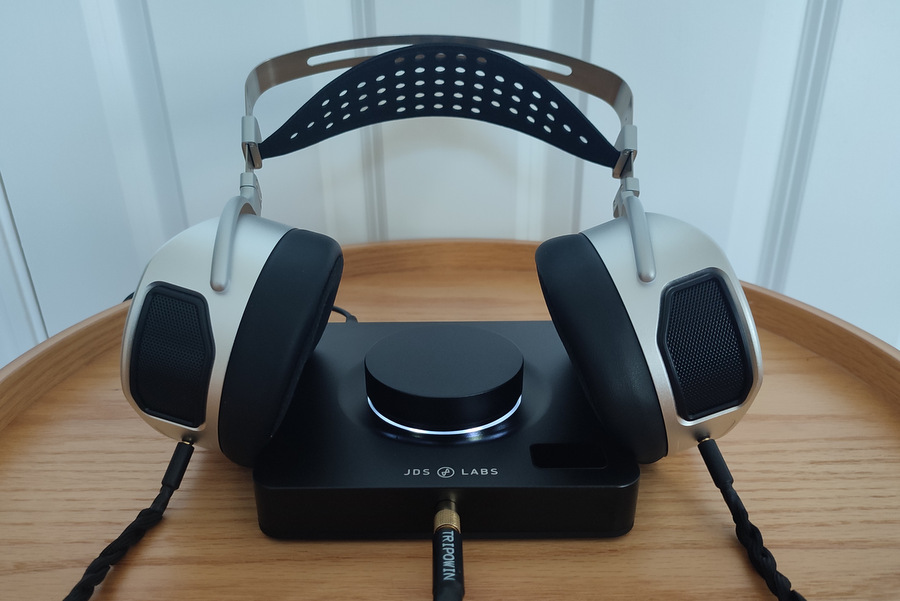
The Bottom Line
The HiFiMAN Isvarna is a technological marvel, successfully integrating both dynamic and planar magnetic drivers to deliver a sound that’s as captivating as it is immersive. The hybrid driver array is expertly tuned to offer a bass response that’s both deep and textured, while maintaining clarity and precision in the midrange and treble.
While the Isvarna may not be the ideal choice for audiophiles seeking a perfectly neutral frequency response, it excels for those looking for a more dynamic, engaging listening experience. However, these are not inexpensive headphones, and to truly unlock their full potential, a high-powered DAP or desktop amplifier is essential. At their price point, the Isvarna is designed for those who demand high-end performance and are ready to invest in the necessary gear to drive them properly.
Pros:
- All-day wearing comfort
- Addictive and well-controlled bass-forward sound
- Class-leading soundstaging and holography
Cons:
- Looks bulky on the head
- Elevated upper treble will irk some
- Expensive
- Require a more powerful amplifier
Where to buy:
Related Reading:


